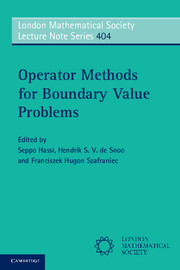Book contents
- Frontmatter
- Contents
- List of contributors
- Preface
- 1 John Williams Calkin: a short biography
- 2 On Calkin's abstract symmetric boundary conditions
- 3 Boundary triplets and maximal accretive extensions of sectorial operators
- 4 Boundary control state/signal systems and boundary triplets
- 5 Passive state/signal systems and conservative boundary relations
- 6 Elliptic operators, Dirichlet-to-Neumann maps and quasi boundary triples
- 7 Boundary triplets and Weyl functions. Recent developments
- 8 Extension theory for elliptic partial differential operators with pseudodifferential methods
- 9 Dirac structures and boundary relations
- 10 Naĭmark dilations and Naĭmark extensions in favour of moment problems
- References
5 - Passive state/signal systems and conservative boundary relations
Published online by Cambridge University Press: 05 November 2012
- Frontmatter
- Contents
- List of contributors
- Preface
- 1 John Williams Calkin: a short biography
- 2 On Calkin's abstract symmetric boundary conditions
- 3 Boundary triplets and maximal accretive extensions of sectorial operators
- 4 Boundary control state/signal systems and boundary triplets
- 5 Passive state/signal systems and conservative boundary relations
- 6 Elliptic operators, Dirichlet-to-Neumann maps and quasi boundary triples
- 7 Boundary triplets and Weyl functions. Recent developments
- 8 Extension theory for elliptic partial differential operators with pseudodifferential methods
- 9 Dirac structures and boundary relations
- 10 Naĭmark dilations and Naĭmark extensions in favour of moment problems
- References
Summary
Abstract This chapter is a continuation and deepening of Chapter 4. In the present chapter the state/signal theory is extended beyond boundary control and beyond conservative systems. The main aim is to clarify the basic connections between the state/signal theory and that of (conservative) boundary relations. It is described how one can represent a state/signal system using input/state/output systems in different ways by making different choices of input signal and output signal. There is an “almost one-to-one” relationship between conservative state/signal systems and boundary relations, and this connection is used in order to introduce dynamics to a boundary relation. Consequently, a boundary relation is such a general object that it mathematically has rather little to do with boundary control. TheWeyl family and γ-field of a boundary relation are connected to the frequency-domain characteristics of a state/signal system.
Introduction
The theory of boundary relations has been developed by a number of authors in the framework of the theory of self-adjoint extensions of symmetric operators and relations in Hilbert spaces; see e.g. the recent articles [Derkach et al., 2006; Derkach, 2009; Derkach et al., 2009; Behrndt et al., 2009]. Boundary relations are described in detail in Chapter 7.
One way of introducing the notion of a state/signal (s/s) system is to start from an input/state/output (i/s/o) system. By a standard i/s/o system we mean a system of equations of the type
where ẋ stands for the time derivative of x.
- Type
- Chapter
- Information
- Operator Methods for Boundary Value Problems , pp. 87 - 120Publisher: Cambridge University PressPrint publication year: 2012



